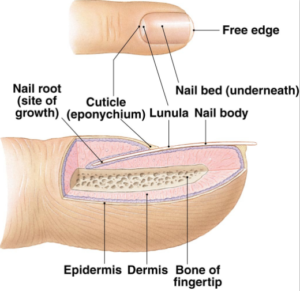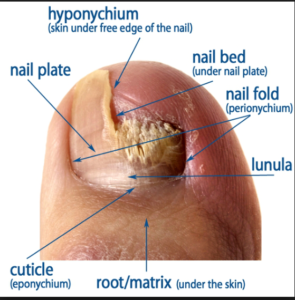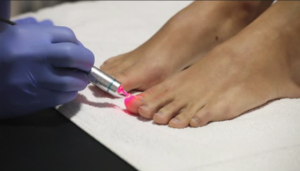
03月24 What is Nail fungus ?
Nail fungus is a common condition that begins as a white or yellow spot under the tip of your fingernail or toenail. As the fungal infection goes deeper, nail fungus may cause your nail to discolor, thicken and crumble at the edge. It can affect several nails.
If your condition is mild and not bothering you, you may not need treatment. If your nail fungus is painful and has caused thickened nails, self-care steps and medications may help. But even if treatment is successful, nail fungus often comes back.
Nail fungus is also called onychomycosis (on-ih-koh-my-KOH-sis). When fungus infects the areas between your toes and the skin of your feet, it’s called athlete’s foot (tinea pedis).


Symptoms
You may have nail fungus if one or more of your nails are:
- Thickened
- Whitish to yellow-brown discoloration
- Brittle, crumbly or ragged
- Distorted in shape
- A dark color, caused by debris building up under your nail
- Smellling slightly foul
Nail fungus can affect fingernails, but it’s more common in toenails.

Causes
Fungal nail infections are caused by various fungal organisms (fungi). The most common cause is a type of fungus called dermatophyte. Yeast and molds also can cause nail infections.
Fungal nail infection can develop in people at any age, but it’s more common in older adults. As the nail ages, it can become brittle and dry. The resulting cracks in the nails allow fungi to enter. Other factors — such as reduced blood circulation to the feet and a weakened immune system — also may play a role.
Toenail fungal infection can start from athlete’s foot (foot fungus), and it can spread from one nail to another. But it is uncommon to get an infection from someone else.
Risk factors
Factors that can increase your risk of developing nail fungus include:
- Being older, owing to reduced blood flow, more years of exposure to fungi and slower growing nails
- Sweating heavily
- Having a history of athlete’s foot
- Walking barefoot in damp communal areas, such as swimming pools, gyms and shower rooms
- Having a minor skin or nail injury or a skin condition, such as psoriasis
- Having diabetes, circulation problems or a weakened immune system
Complications
A severe case of nail fungus can be painful and may cause permanent damage to your nails. And it may lead to other serious infections that spread beyond your feet if you have a suppressed immune system due to medication, diabetes or other conditions.
If you have diabetes, you may have reduced blood circulation and nerve supply in your feet. You’re also at greater risk of a bacterial skin infection (cellulitis). So any relatively minor injury to your feet — including a nail fungal infection — can lead to a more serious complication. See your doctor if you have diabetes and think you’re developing nail fungus.
Prevention
The following habits can help prevent nail fungus or reinfections and athlete’s foot, which can lead to nail fungus:
- Wash your hands and feet regularly. Wash your hands after touching an infected nail. Moisturize your nails after washing.
- Trim nails straight across, smooth the edges with a file and file down thickened areas. Disinfect your nail clippers after each use.
- Wear sweat-absorbing socks or change your socks throughout the day.
- Choose shoes made of materials that breathe.
- Discard old shoes or treat them with disinfectants or antifungal powders.
- Wear footwear in pool areas and locker rooms.
- Choose a nail salon that uses sterilized manicure tools for each customer.
- Give up nail polish and artificial nails.

Here is our 4 in 1 980nm laser machine, if you want to get more details, you can visit our website www.starnewtech.com or directly contact me by whatsapp +86 15032576489.





No Comments